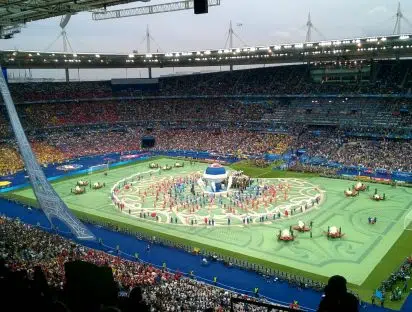It is only recently that the excellent German intellectual weekly newspaper DIE ZEIT – whose quality was recently (and rightly) praised by Simon Kuper – introduced a football page. Yet another proof of the game’s increasing socio-cultural and political impact.
The page still has to find a stable quality: the interviews are generally very good, but I am afraid not every article is a highlight – sometimes it’s simply well-formulated trivialities, sometimes the texts are simply beside the point. But once in a while it provides tasty food for thought.
The recent article ‘After the earthquake’ (DIE ZEIT No. 42/2015, from 15 October), by journalist Cathrin Gilbert and Hans Ulrich Gumbrecht, the renowned literature theorist and philosopher from Stanford University, is a good example for the latter case. With regard to the current FIFA scandal(s), they go beyond condemning the obvious in an attempt to design a fundamentally new approach to global football governance.
According to them the perspective must change completely: rather than overloading football with a symbolic meaning it does not inherently possess, but which opens the door to all kinds of political and economic manipulation of the game and its governance bodies, they call for a new ‘sobriety’.
What is needed, according to Gilbert and Gumbrecht, is a professional management of football by ‘cold specialists’, who unlike the ‘hot amateurs’ who run the game in the national and international federations – all the Platinis, Beckenbauers, Blatters or Niersbachs – are not flawed in their decision-making by ‘emotional investment’.
The author’s basic assumption that ‘football does not have any higher, intrinsic values’ is sound. But the conclusions they draw from it are wrong. Firstly, their claim that the components of football tradition (old clubs, legendary stands, etc.) are ‘only a souvenir of football history, but no longer a central phenomenon’, i.e. simply ‘elements of nostalgia that enhance the attractiveness of the event in the stadium’, is misleading. Just because something is more imagined than real does not mean it is not of utmost importance to those who believe in it.
Secondly, the alternative they describe – taking inspiration on the American model of professional sport, complete with closed leagues, franchises, salary caps, draft and occasional updates of the rules – would turn out, as much as Professor Gumbrecht admires its efficiency, to be very counter-productive when applied to European football – especially for ‘cold specialists’ who aim at maximising its entertainment impact and business potential.
Thirdly, the authors’ declaration that national teams have become obsolete seems simply runs against evidence. They describe the World Cup as a ‘grotesque exception to the kind of football that has conquered the world’ and ask the rhetorical question whether ‘the double-coding of football’ – in club competitions and national teams – is still necessary. My answer is very simple: ‘Yes, it is. Maybe not necessary, but very efficient.’ We’ve had this discussion in the 1990s, but the popular response to the French World Cup and the following ones have clearly shown that there is not only room for two footballs, but that they actually need each other (1).
We are living the age of two footballs and it happens to be an age of unprecedented popular and economic success for both club football and national teams. In the wake of the paradigm shifts of the 1990s, they have undergone a ‘mutually beneficial divorce’, which has helped them to adapt remarkably smoothly to the dialectics of cultural globalisation between enjoyment of postnational, multicultural creolisation and the longing for nostalgic, cultural singularity (2). Epitomised in the English Premier League and the UEFA Champions League, postmodern club football stands for unlimited mobility and multiculturalism, while at the opposite end of the football spectrum the national teams represent strong roots and a kind of imaginary, untainted, not-for-profit cultural ‘purity’. Their perceived antagonism has not only stabilised, but actually reinforced their appeal (and their revenues). Football’s global community of fans wants both. They are, as I put it at the WCSF conference in Copenhagen last May, at the same time ‘smart consumers and hopeless romantics’ (3).
All of us are, to various degrees. It’s the human condition in the times we have been put in. And football is a lovely looking glass for observing ourselves.
(1) See my chapter ‘France 98 – a Watershed World Cup’ in: Kay Schiller and Stefan Rinke (eds), The FIFA World Cup 1930 – 2010. Politics, Commerce, Spectacle and Identities. Göttingen: Wallstein-Verlag, 2014, pp. 318-336.
(2) See the final chapter of my book Les identités du football européen, Presses universitaires de Grenoble, 2008, or my article in Les Cahiers du Journalisme No. 19, 2009.
(3) ‘Smart consumers and hopeless romantics’ is also the title of my forthcoming contribution to the conference proceedings.
Featured photo: The 4th goal of Uruguay v. Argentina national team scored by Héctor Castro. See page for author, Public domain, via Wikimedia Commons





